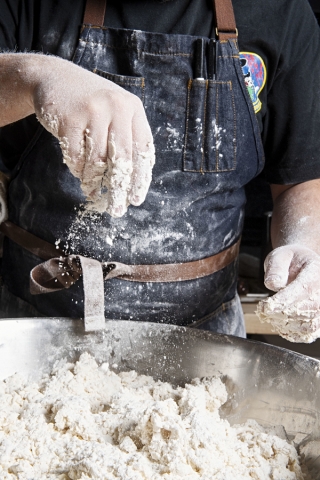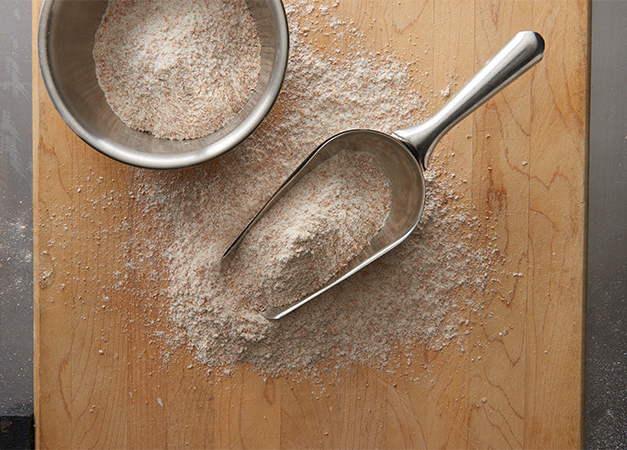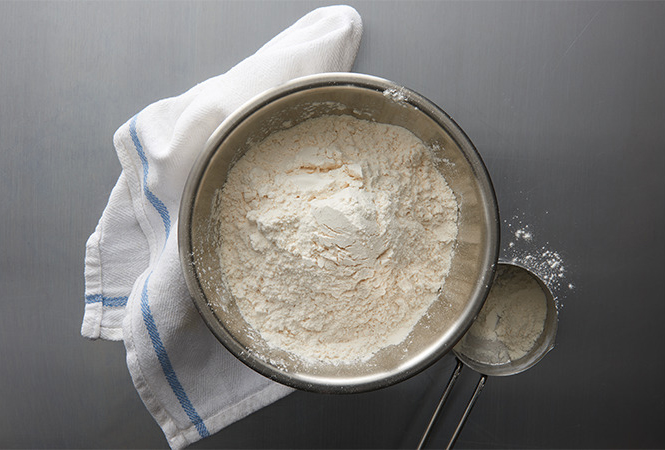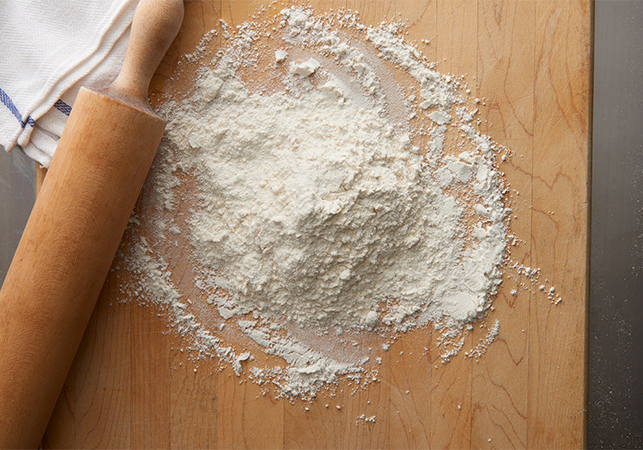
Knowing Flour’s Baking Job
03 April 2023Understanding the functionality of flour opens so many baking doors – there won’t be anything a baker cannot make.
By Lisa Parrish, GMC Editor
Feedback & comments: This email address is being protected from spambots. You need JavaScript enabled to view it.
Curt Wagner is a member of the Chefs of the Mills, a team of culinary thought leaders at General Mills Foodservice who provide insight to foodservice personnel. Passionate about pastry and baking from a young age, Chef Wagner enjoys sharing his expertise in flour and technical baking as a teacher and trainer for food-management companies, bakeries, pizzerias, and foodservice operators that work with General Mills Foodservice. Now he can add culinary educators to his list of students and trainees.
I recently asked Chef Wagner to discuss the intricacies of a basic ingredient: flour. Even though flour is a component of nearly every food item from breakfast to dessert, it is a complex and nuanced ingredient. For example, the season the wheat is grown in will impact which flour a chef should choose for a baked good formula. A baker must also know a flour’s protein and starch levels before reaching for the flour container. Bleached flour may be less expensive but is it the best for all applications? (Hint: the answer is no.)
Read on to discover the many different roles flour plays in baking and cooking.
Please discuss the impact of protein and starch levels in baked goods.
The easiest way to think about flour is this: first, flour contains starch; and secondly, flour contains protein. The higher the protein level the lower the starch. The opposite is also true. Once I decide what I want my flour to do, I can then pick the appropriate type of flour to use. When making a bagel, I want a high-protein flour, typically above 12% protein, as this will give me the gluten strength. At 12% protein, my bagel will have a little chew to it which I want in a bagel. If I want more chewiness, then I would go up to 14% protein which is very strong and will get me that beautiful NY-style bagel. The more protein, the more strength.
Now, when making something more delicate like a sponge cake, I don’t want that strong of a flour because a chewy cake is no bueno. I go to less protein and higher starch where I am looking in the 8-9% protein range of flour. This gives me the tenderness and melt-in-your-mouth feel I love in cakes and cookies.
When it comes to water, the higher the protein the more hydration a flour can handle. You really need to understand the job you need your flour to do before you start a project.
 Can you talk about the different flours produced by hard and soft wheat? Also, the different flours produced by red and white wheat?
Can you talk about the different flours produced by hard and soft wheat? Also, the different flours produced by red and white wheat?
Hard wheats are planted in the Spring and harvested in the late Summer, which makes them stronger. They are usually in the 12-14% protein range. This is contrary to softer (Winter) wheat, which is planted in the Fall and harvested in late Spring/early Summer and typically has 10-12% protein.
Again, this goes back to what job you want your flour to do. Some formulas can’t use Winter wheat because they need more protein.
In the difference between red and white wheat, red wheat tends to have more tannin which can give a little different note to the end product. A good example is in regular whole wheat flour (red wheat) vs white whole wheat flour (white wheat), the white wheat will lend itself to have a little sweeter note.
(Click here to learn more about wheat. Just as flour is not “just flour,” wheat is not “just wheat.” Be sure to look at the final page of the document for a chart indicating types of flours and their best use in applications.)
Why is All purpose flour the most widely available?
I would say because of its versatility. You can make almost anything from it because All purpose flours tend to be a blend of hard and soft wheats, so cookies, cakes, pastries, breading and breads can be made from All purpose flour.
Some folks are surprised they can make their own All purpose flour. If they are using a favorite Bread flour as well as a favorite Pastry flour, just blend an even amount of each to get an All purpose flour.
What is a surprising fact about one type of flour?
We have a flour called Wondra and it is encapsulated so it is somewhat granular. This is a fantastic product because it can not only be used to thicken fruit fillings for pies and strudels, but it works great on a pizza peel to aid in sliding the pizza into the oven. Plus, it doesn’t burn like semolina.
Can you discuss the nuances of using gluten-free flour in baking applications? Do you have any advice on swapping flours in diet-restricted applications?
This is a tricky area because you really need to play with a formula to get to where it works best for you. You must take into account the type of oven, the pan it will be baked in, and the finished product thickness as well.
I am a huge trial-and-error dude. I will first try a gluten-free flour to see how it performs. I have used our Pillsbury brand gluten-free flour with good results. If you look at the base ingredients of gluten-free flour, you can personalize it and make your own.
Why bleach flour?
Bleaching flour makes it whiter and usually has no effect on the baking performance. But in Cake and Pastry flour, chlorine gas improves performance by lowering the pH. Bleached flour gets to market quicker which in turn lowers consumer costs. Natural aging of the flour takes more time making it more expensive.
What are bromated and untreated flours?
Bromated flours are treated with potassium bromate to mature the flour and give the dough more strength. It can also improve the rise and elasticity. Bromate is a banned food additive in several countries as it has been shown to be a carcinogenic.
Untreated is my go-to flour. Although it is a little more expensive, because it takes time for the flour to naturally age and mature, there are no added chemical agents and it is a clean-label item.
 How many different types of flour are available (not including gluten-free varieties)?
How many different types of flour are available (not including gluten-free varieties)?
There a quite a few. General Mills has Semolina, Cake, Pastry, All purpose, Bread, High gluten, Rye, Whole wheat, and Clear flours. There are different styles of flours that will also fall into these categories, the most common being pizza flours.
What is your favorite application using a specific flour type and why?
This is a tough question. I love to bake and because I enjoy almost any kind of baked good, it requires the use of many different flours. So, it’s hard to choose one. The cool thing with flour is you can do so many different things, which requires many different flours. I love making laminated doughs just as much as making pizza dough. And who doesn’t love a good cookie? I will leave you with this; when you understand the functionality of your ingredients there isn’t anything you can’t make.
About Chef Curt Wagner
Prior to joining the General Mills in 2014, Curt worked with one of the nation’s most prominent retailers to train its baker associates on the art of baking breads, cakes and donuts. He joined the Chefs of the Mills team in 2020.
With decades of baking and pastry expertise, Chef Curt has been a pastry sales consultant, an executive pastry chef at Minnesota’s Italian eatery, and a chef instructor for Keiser University and the Culinary Institute of America.

